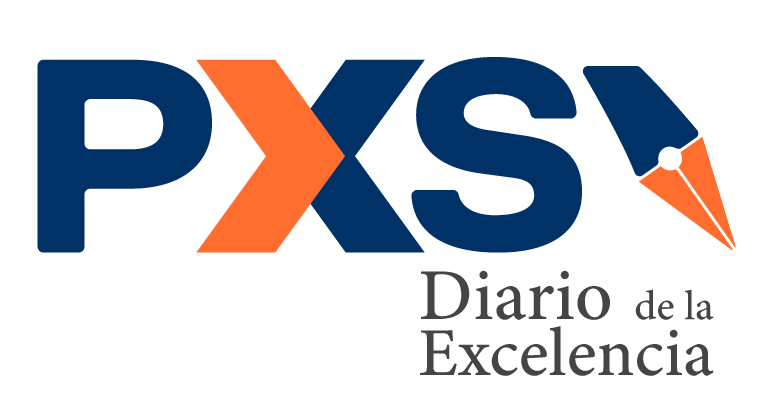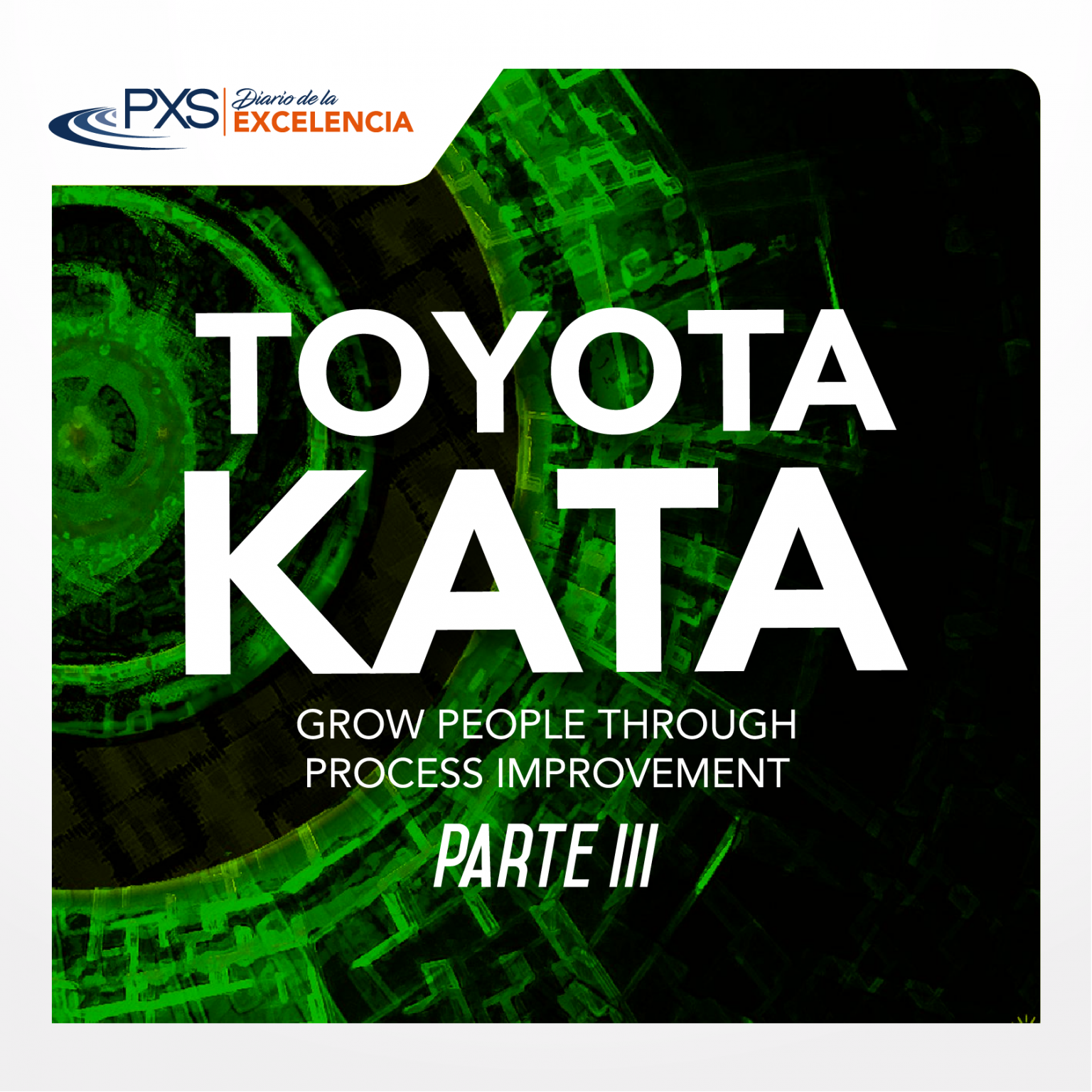This is a People Business:
TOYOTA KATA – PART III:
This is the last of the three-part post, Toyota Kata – Develop the Science and the Scientist for Process Improvement. For the previous posts, see Toyota Kata – Part I, and Toyota Kata – Part II. Thus far I note common lean tools that serve a deeper purpose when applied in a Kata environment. I couple these Lean tools with the Shingo Principles to illustrate congruency. I would love to hear your personal stories with Kata and your ideas about how to implement in your organization. Please contact me directly to discuss. So what is the Coaching Kata? Let’s take a look!
Now that we understand the routine and scientific methodology of the Improvement Kata, we shift our attention to the method of leveraging the Kata. Note that the method is more than implementing. Likewise, we don’t simply teach the model and delegate the execution to the next level. The Coaching Kata is the means by which the Learner grows in capability, while the collective team gains in business results. The Coaching Kata is the interaction between Mentor & Learner that rapidly, yet incrementally pulls for process improvement. Mike Rother has codified the method into a simple Question & Answer model that is reminiscent of the Socratic Method. His “5 Questions” are intended to set kata (or routine) of interaction between Learner & Mentor. Inherent in the questions is an implicit absence of direct instruction and rather a constant pull of learning from the Learner. I will tell you, that this certainly feels uncomfortable at first! The Mentor more naturally wants to share what he thinks to be the solution, while the Learner more readily wants to be told what to do to fix the problem. Recall the Confirmation Bias, where the Mentor or boss typically will start at a point he already has the answer, that’s why he’s the boss, right? This Coaching Kata approach helps channel both parties to keep in check the bias to jump to solutions before exercising the basic scientific method or the Improvement Kata.
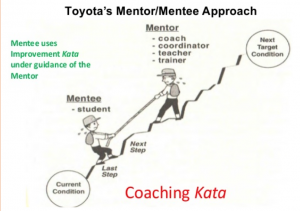
COACHING KATA PRINCIPLES:
The Shingo Model reminds us that in order to achieve our ideal culture with long term sustainment of business results, we must establish systems and tools that drive ideal behaviors. Such behaviors need to achieve aligned business results that are 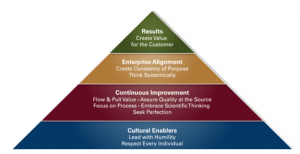 derived from scientific process improvement, while respecting all individuals. Well that is a tall order! So how do we connect the front-line associates with the top-level results? The Coaching Kata helps bridge that gap by growing the people. Mentors grow to be better leaders, while Learners grow to develop better processes. Take a look at certain principles that Rother sets forth to describe this Learner / Mentor relationship and see the tone of Shingo principles at play:
derived from scientific process improvement, while respecting all individuals. Well that is a tall order! So how do we connect the front-line associates with the top-level results? The Coaching Kata helps bridge that gap by growing the people. Mentors grow to be better leaders, while Learners grow to develop better processes. Take a look at certain principles that Rother sets forth to describe this Learner / Mentor relationship and see the tone of Shingo principles at play:
- “If the learner hasn’t learned, the teacher hasn’t taught.”
This slogan reminds us that the Mentor’s job is not complete just because instructions have been issued. Until the Learner has gained experience that leads to insight, the Mentor still needs to coach.
- Everyone has a mentor.
All levels need to be coached. This method of problem solving is not natural for most of us. We need a mentor to socratically help us along.
- Mentor does more asking than telling (more listening, less talking).
This is a great reminder of what we learned in grade school, listen more than we talk. Most of us feel that the position of leadership comes with a need to talk, solve problems, and suggest the best solutions.
- Mentor pulls for understanding, not just for solutions and next steps
The Socratic method takes discipline and patience, and thus lots of practice. It’s much more natural to provide the answers. Most of us were promoted because in fact we are good at providing solutions, yet our future leadership skills will require more leading than fixing.
- Value of single factor experiments
It is more natural for us to try a solution set, than to try single facet of the set. Our Learners will also naturally want to implement their solution set that fits with their confirmation bias. It takes scientific discipline to craft simple one variable tests.
- “Show me”
It’s our natural tendency, again from our inherent biases to want to explain, theorize, or hypothesize our suggestions rather than to organize them into simple tests that demonstrate our idea. Mentors will need to resist the urge to accept words alone. Better to guide the Learner to go to gemba, observe real work, collect real data with live eyes. “Show me” goes hand in hand with the lean principle of Gemba.
- Focus on the understanding the Process, not on implementing countermeasures.
In business, we tend to focus much more on results than the means of those results. That may be different in academia. This hyper focus on countermeasures may lead to unsustained solutions. We may hit the lucky solution, but we will carry little knowledge forward for the next challenge that arises.
- Focus on process, not people.
This is a common statement in lean philosophy but it’s worth restating. Our Learners may be quicker to associate the issues to human factors rather than process facts. This is so natural, it will take a conscious effort on part of the Mentor to redirect the Learner back to the process when fingers start pointing to an individual.
- Testing over Talking.
This is similar to “Show me” but goes a bit deeper. We are all guilty of simply having the right solution. Our experience tells us that we know the answer. This principle reminds us to validate assumptions with simple experiments. Such tests will almost always teach us more of the process we are studying and will often disprove a bias or assumption. Remember that failed tests will teach us more than our supposed true hypotheses. That’s easy to say but harder to appreciate when bonuses are often granted for the correct solutions.
“5 QUESTIONS”
The interaction between the Mentor & Learner is codified into what Rother calls the “5 Questions.” I first should state that the 5 Questions are not limited to five! Like the classic lean tool “5 Whys”, the number is not the point as much as the cadence of asking the same questions each time. Again, this will feel rote and unnecessarily repetitive at the beginning. Soon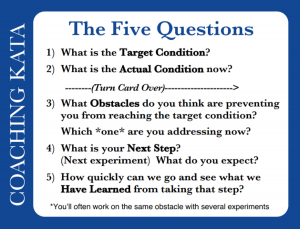 you will see that both the Learner & the Mentor in fact rely and gain confidence by knowing exactly what questions will be asked in the exchange. Likewise, the established cadence of the Q&A will set a pattern that makes the conversation efficient and crisp. This in turn facilitates rapid iterations of PDCA and testing.
you will see that both the Learner & the Mentor in fact rely and gain confidence by knowing exactly what questions will be asked in the exchange. Likewise, the established cadence of the Q&A will set a pattern that makes the conversation efficient and crisp. This in turn facilitates rapid iterations of PDCA and testing.
5 Questions:
- Align the discussion to the bigger objective.
- Start off the discussion with gemba like reflection of the current state
- Review last steps (what happened, what was observed, what was learned)
- Pull for focus on the single biggest obstacle at that time.
- Establish short term follow up.
THE KATA WALK DISCUSSION:
This is a good time to remind us of the visual presentation of the Improvement Kata information on the Kata Board. This board, like an oversized A3, holds all the information that will be shared in the Coaching Kata discussion between the Learner & Mentor. You will note in the example that the questions are asked word-for-word from the 5 Questions card. Likewise, the Learner’s response is organized on the board and shared back with little embellishment, expounding, or ad-lib. The exchange is quite succinct. This is done primarily to pull the learner into the next iteration of testing and validation, not to solve the issue by talking.
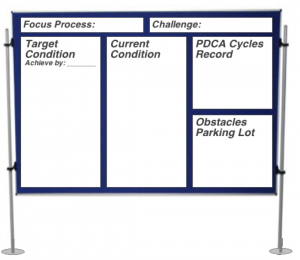
LIVE COACHING KATA EXAMPLE:
It will be helpful to observe a live Coaching Kata. Click on the link below of a video hosted by Rother. This is a real example of Kata in practice at Merck.
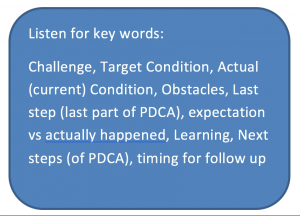
DEEPER DIVE, A CHAIN OF KATA:
If we dive one level deeper, we see that an entire value stream can unite around a large-scale Challenge. Each function or sub team of the value stream will have somewhat different Target Conditions based on their individual contribution to the goal. Watch how Merck links a chain of Kata Target Conditions to accomplish a large-scale operational Challenge. You can see various Shingo Principles at play, all these ultimately grow the individuals, exercise a scientific approach to improvement, and ultimately yield aligned business & customer results.
TOYOTA KATA & SHINGO OVERVIEW:
The Shingo Model illustrates how ideal results follow ideal behaviors, and similarly how our principles and systems drive our behaviors. The Improvement & Coaching Kata are in that tool kit. From my experience, this model can be a powerful approach to process improvement that also brings along people development! The results scale from small and incremental to operation-wide initiatives. I have enjoyed exercising the approach and would love to hear your ideas or war stories related to the same. This really is a people business!
Contact me at Trevor Bosen – LinkedIn, or WhatsApp +1 801 381 6118.

